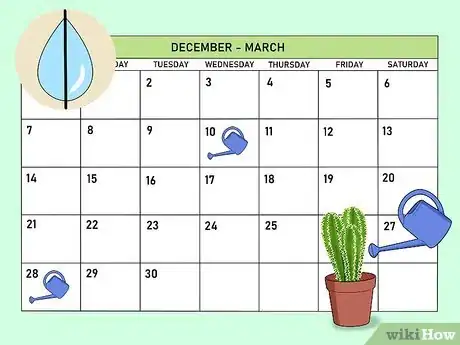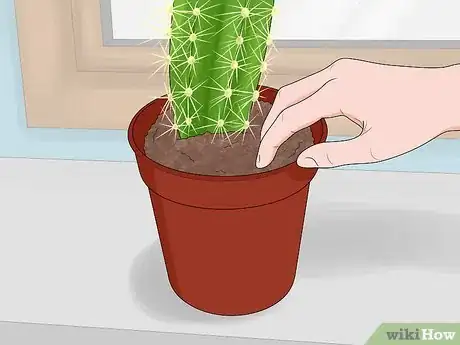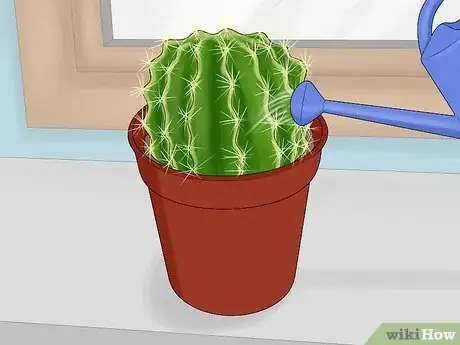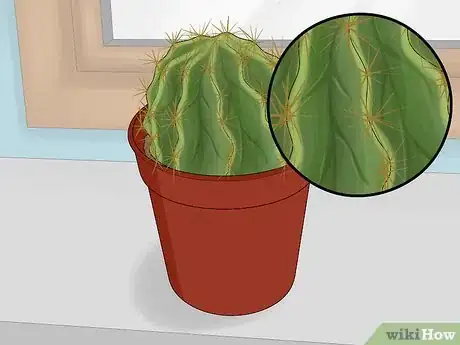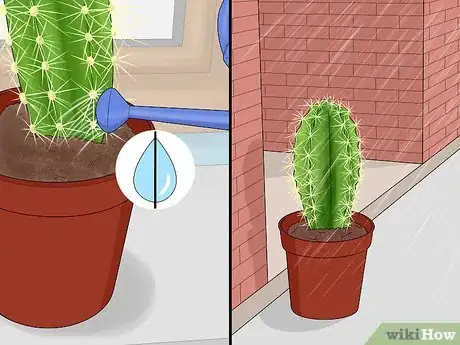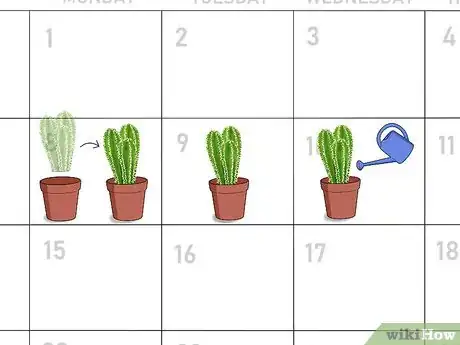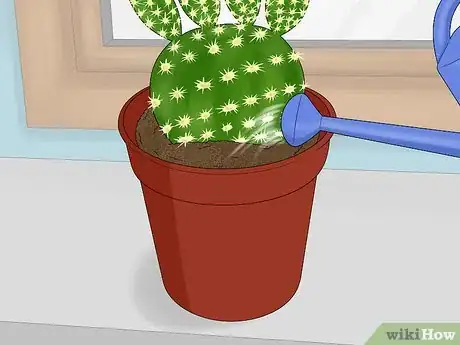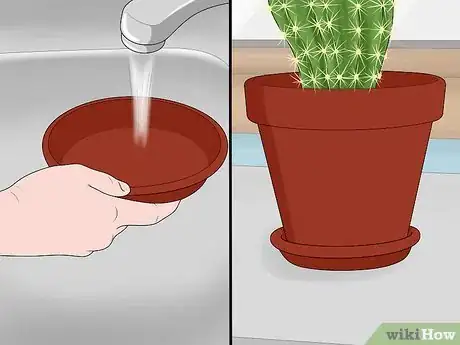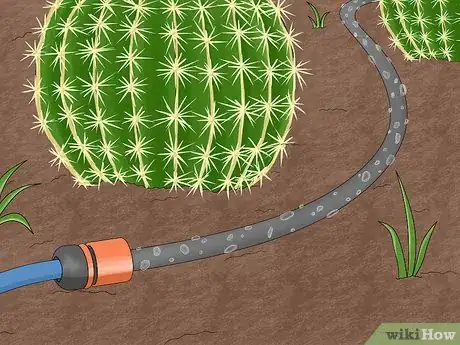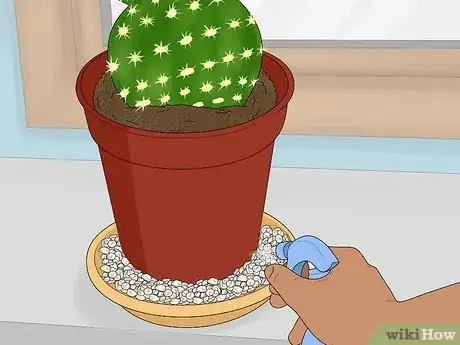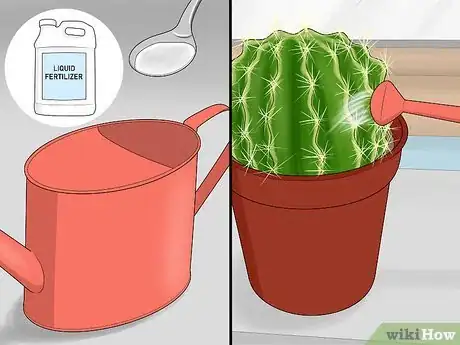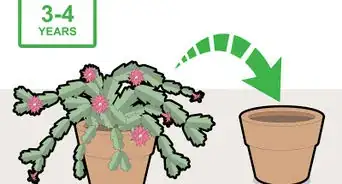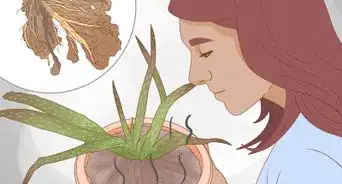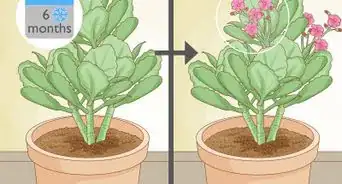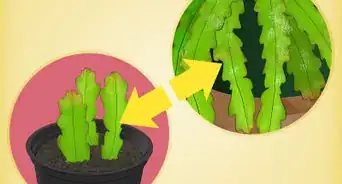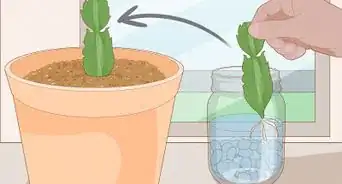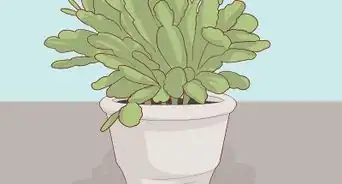This article was co-authored by Harmony Corelitz. Harmony Corelitz is a Plant Specialist and the Ecommerce Manager at Crimson Horticultural Rarities, Inc, a boutiue offering rare plants, flower arragements, and handmade goods. Harmony grew up helping her parents run their family business in plant maintenance and interior plantscaping. Harmony specializes in indoor plant care and interior plant design. Prior to her workwith Crimson Horticultural Rarities, she started her pop-up plant and vintage home goods shop called Younger Child and helped her former employer, Plants and Friends, grow and expand to two locations. She holds a BA from the University of San Francisco.
There are 13 references cited in this article, which can be found at the bottom of the page.
This article has been viewed 29,423 times.
When people think of a cactus, they picture deserts without much water at all. Cacti are low-maintenance, making them great household plants, but they require more water than you may expect. They have to be watered at least once a week, especially during the warmer months of the year. The easiest way to water them is with a watering can, although there are other techniques you can take advantage of as well. Tropical cacti also have slightly different needs than desert cacti, such as a higher humidity level. With timely watering, your cactus can add some color to your home.
Steps
Choosing When to Water a Cactus
-
1Water cacti at least once a week in the spring and summer. Cacti grow from March to September in the northern hemisphere, so that is when they need the most water. While your cactus is active, thoroughly water the soil to keep it moist. Keep in mind that factors like exposure to sunlight also affect how fast the soil dries out. During hot, dry weather, you may have to add water 2 or 3 times a week.[1]
- If you’re in the southern hemisphere, remember to water your cactus more often from September to around March instead.
- During this time, you can also give your cactus some fertilizer. Use a balanced fertilizer and dilute it in the water you add to the soil.
-
2Reduce waterings to every 2 to 4 weeks in winter. Most types of cacti stop growing in the fall. Although they are sleeping, they still need a little bit of water to survive! Monitor the quality of the soil. When the soil dries out, water it thoroughly to keep your cactus well-nourished.[2]
- Overwatering is just as dangerous as underwatering a cactus. Remember that they don’t need a lot of water anyway, but it’s even less when they’re dormant.
Advertisement -
3Touch the soil to feel if the first 3 in (7.6 cm) feel dry. Deciphering the needs of a slow-growing cactus can seem impossible sometimes, but the soil is a good hint about what to do next. Stick your finger down into the soil. If it feels dry, then you know it’s time to water the cactus again. If it feels wet and sticks to your finger, then you can wait.[3]
- You could also stick a gardening stake tool in the soil. Wet soil will stick to the stake. Another option is to use a moisture meter to instantly detect the soil’s condition.
-
4Water tropical cacti before the soil has completely dried out. Tropical plants like the Christmas cactus are not drought-tolerant like desert cacti are. If you happen to have a tropical cactus, make sure the soil is always a little moist. Tropical cacti are much more prone to underwatering than desert cacti. If you have a desert cactus, you can wait until the soil has finished drying out to ensure you don’t overwater it.[4]
- Tropical cacti still only need to be watered about once a week. You just have to check the soil a little more often to ensure it doesn’t get too dry.
-
5Watch your cactus for signs of shriveling when the soil is too dry. Monitoring changes in your cactus’ appearance can also help you figure out when to water the soil. If your cactus starts to shrink, then it most likely needs more water. Its skin will begin to crinkle up, leaving your cactus looking small and wrinkly. Give it a drink of water and see if it recovers.[5]
- Note that shriveling can be caused by other problems, such as the roots becoming tangled and unable to absorb water. If the soil feels moist, then check for diseases, insects, changes to the environment, and other problems.
-
6Give your cactus less water if you leave it out in the rain. Depending on how much rain your area gets, you might not need to water your cactus at all. Instead, leave it out in the sun to dry out. As long as the pot and soil have adequate drainage, your cactus will be fine. Monitor the soil’s quality afterward to tell when it dries out and requires more water again.[6]
- If your area is due to receive heavy rain over several days, take your cactus inside so it doesn’t get too soggy. Soggy soil leads to root rot, so make sure it has plenty of time to dry out.
- A potted cactus will be safe outdoors as long as its soil drains well. Many varieties can even survive in temperatures under 32 °F (0 °C) as long as they are kept dry.
-
7Wait at least a day before watering a repotted cactus. Help your cactus adapt by making its new home as inviting as possible. Put the cactus in its pot and cover the roots. Later on, water the soil lightly until the first 3 in (7.6 cm) stay wet. Watch the soil condition afterward while transitioning to weekly watering.[7]
- If you have a tropical cactus, be sure to water it before it completely dries out. Watch for any signs like shriveling.
- Some growers prefer to wait as long as 1 week before watering a repotted cactus. If you took a cutting, waiting gives the cactus time to heal so it doesn’t become infected or waterlogged.
Picking a Watering Technique
-
1Pour water around the base of the cactus for a straightforward way to water it. Use a watering can or sprayer to soak the soil, leaving the cactus dry. Lukewarm tap water is fine, but you can use an alternative if you have one. Keep adding water until it flows out from the drainage holes at the bottom of the container. If you’re using a container without drainage holes, add enough water to moisten the upper 3 in (7.6 cm) of soil. Check back in about 2 hours to see if the soil is still moist and add more water as needed.[8]
- Most home growers water cacti this way. It’s simple and effective. It gives you much more direct control over how much water you introduce to the soil.
- Some cacti grow very wide and make it hard for you to reach the soil. If this is a problem, try watering it from the bottom-up with a planter saucer.
- Spraying a cactus directly could spread bacteria or root rot. Unless you’re in an area with a bone-dry summer or winter, avoid misting a cactus.
-
2Fill a planter saucer with water for a more efficient way to water desert cacti. Most cacti grown at home happen to be from the desert, and these varieties have long roots that pull water from deep within the soil. To water one, get a saucer, fill it up with lukewarm water, then place it underneath the cactus’ pot. Come back in 2 hours to check on it. If the soil is moist halfway down, then your cactus has enough water to last until the next watering session. Remove the saucer afterward.[9]
- Tap water is safe to use, but rainwater and distilled water are better due to their lack of minerals.
- You can also use a planting tray or even a plastic container. A planting tray comes in handy for watering multiple cacti at once.
- Many desert cactus lovers prefer using this method, but you can make the soil too wet if you’re not careful. If you’re unsure or notice problems, top-down watering will be fine.
-
3Irrigate with a dripping hose for a more controlled watering. This is a useful method for bigger cacti and those planted outdoors. Set a garden hose nearby, making sure it isn’t touching the cactus. Turn on the water so it begins dripping lukewarm water at a slow but steady rate. After 2 to 6 hours, shut off the hose.
- You will have to use tap water unless you have a way to pipe rainwater through a hose, such as a rain barrel with a hose attachment.
- If your cactus is in a pot, look for water coming out of the drainage holes. The soil at the bottom of the pot, around the roots, will also stay damp.
- Bigger cacti need more water. A barrel cactus will have enough water after 2 hours, but err toward 6 hours for something like a tall Saguaro.
-
4Place water near a tropical cactus for humidity. Tropical cacti require a little additional moisture. One way to do this is by filling a small container with gardening pebbles. Mist the pebbles with water, then set the potted cactus on top of it. Check the pebbles when you water the cactus and spray them to keep them damp.[10]
- You could also keep a dish of water near the cactus to evaporate over time. Misting the cactus with a little bit of water can help, but it will dry out over time.
- Desert cacti don’t require humid conditions, so keep them away from excess moisture. Your home has the perfect humidity level for them.
-
5Add a balanced liquid fertilizer to the water during the growing season. If you wish to give your cactus a little boost, add liquid fertilizer to the water. Pick a balanced or low-nitrogen houseplant fertilizer. Dilute it to half its strength according to the directions on the bottle, such as by adding about 1⁄2 teaspoon (2.5 mL) per 1 US gal (3,800 mL) of lukewarm water. Then, use it to water the plant once or twice in the spring and summer.[11]
- Try using a fertilizer rated 20-10-20 or 20-20-20, for instance. The first number represents nitrogen, while the third one represents potassium.
- For example, you could water the plant with fertilizer at the beginning of spring and at the beginning of summer.
- Tropical plants like the Christmas cactus can be fertilized once a month during the growing season.[12]
Expert Q&A
-
QuestionHow do you water a Christmas cactus?
 Harmony CorelitzHarmony Corelitz is a Plant Specialist and the Ecommerce Manager at Crimson Horticultural Rarities, Inc, a boutiue offering rare plants, flower arragements, and handmade goods. Harmony grew up helping her parents run their family business in plant maintenance and interior plantscaping. Harmony specializes in indoor plant care and interior plant design. Prior to her workwith Crimson Horticultural Rarities, she started her pop-up plant and vintage home goods shop called Younger Child and helped her former employer, Plants and Friends, grow and expand to two locations. She holds a BA from the University of San Francisco.
Harmony CorelitzHarmony Corelitz is a Plant Specialist and the Ecommerce Manager at Crimson Horticultural Rarities, Inc, a boutiue offering rare plants, flower arragements, and handmade goods. Harmony grew up helping her parents run their family business in plant maintenance and interior plantscaping. Harmony specializes in indoor plant care and interior plant design. Prior to her workwith Crimson Horticultural Rarities, she started her pop-up plant and vintage home goods shop called Younger Child and helped her former employer, Plants and Friends, grow and expand to two locations. She holds a BA from the University of San Francisco.
Plant Specialist For a Christmas cactus, just let it dry out about three-quarters of the way or all the way in between waterings.
For a Christmas cactus, just let it dry out about three-quarters of the way or all the way in between waterings.
Things You’ll Need
- Watering can or hose
- Quick-draining pot
- Quick-draining soil
- Balanced or low-nitrogen fertilizer
- Container of gardening pebbles (for tropical cacti)
- Planter saucer or tray (optional)
- Misting bottle (optional)
References
- ↑ https://csssj.org/welcome_visitors/basic_culture.html
- ↑ https://hgic.clemson.edu/factsheet/indoor-cacti/
- ↑ https://www.missouribotanicalgarden.org/Portals/0/Gardening/Gardening%20Help/Factsheets/Cactus%20and%20Succulents10.pdf
- ↑ https://www.gardeningknowhow.com/ornamental/cacti-succulents/scgen/watering-cactus-plants.htm
- ↑ https://aces.nmsu.edu/ces/yard/2000/090900.html
- ↑ https://www.sublimesucculents.com/rain-on-succulents/
- ↑ https://worldofsucculents.com/repot-cactus/
- ↑ https://www.youtube.com/watch?v=LuKCG81pJAE&feature=youtu.be&t=93
- ↑ https://www.youtube.com/watch?v=JM2CUMD3Uss&feature=youtu.be&t=38
- ↑ https://www.flowersandfancies.com/blog/succulents-air-plants-cacti-oh-my/
- ↑ https://extension.umn.edu/houseplants/cacti-and-succulents#fertilizing-1421913
- ↑ https://hgic.clemson.edu/factsheet/thanksgiving-christmas-cacti/
- ↑ https://www.sublimesucculents.com/rain-on-succulents/
- ↑ https://www.centraltexasgardener.org/resource/succulent-and-cactus-soil-mix/

